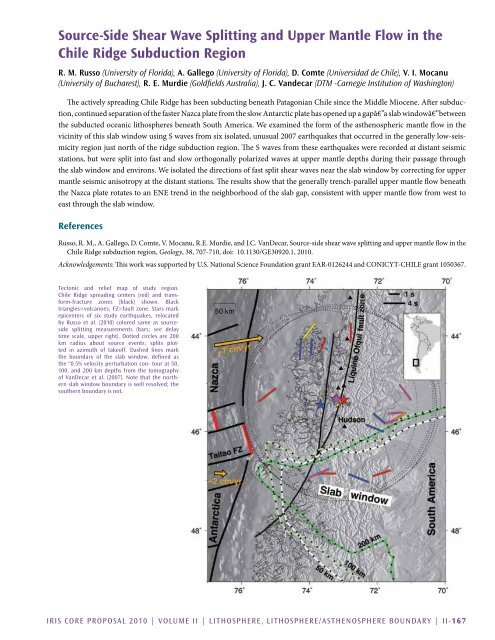Accomplishments - IRIS
Accomplishments - IRIS
Accomplishments - IRIS
Create successful ePaper yourself
Turn your PDF publications into a flip-book with our unique Google optimized e-Paper software.
Source-Side Shear Wave Splitting and Upper Mantle Flow in the<br />
Chile Ridge Subduction Region<br />
R. M. Russo (University of Florida), A. Gallego (University of Florida), D. Comte (Universidad de Chile), V. I. Mocanu<br />
(University of Bucharest), R. E. Murdie (Goldfields Australia), J. C. Vandecar (DTM -Carnegie Institution of Washington)<br />
The actively spreading Chile Ridge has been subducting beneath Patagonian Chile since the Middle Miocene. After subduction,<br />
continued separation of the faster Nazca plate from the slow Antarctic plate has opened up a gap—a slab window—between<br />
the subducted oceanic lithospheres beneath South America. We examined the form of the asthenospheric mantle flow in the<br />
vicinity of this slab window using S waves from six isolated, unusual 2007 earthquakes that occurred in the generally low-seismicity<br />
region just north of the ridge subduction region. The S waves from these earthquakes were recorded at distant seismic<br />
stations, but were split into fast and slow orthogonally polarized waves at upper mantle depths during their passage through<br />
the slab window and environs. We isolated the directions of fast split shear waves near the slab window by correcting for upper<br />
mantle seismic anisotropy at the distant stations. The results show that the generally trench-parallel upper mantle flow beneath<br />
the Nazca plate rotates to an ENE trend in the neighborhood of the slab gap, consistent with upper mantle flow from west to<br />
east through the slab window.<br />
References<br />
Russo, R. M., A. Gallego, D. Comte, V. Mocanu, R.E. Murdie, and J.C. VanDecar, Source-side shear wave splitting and upper mantle flow in the<br />
Chile Ridge subduction region, Geology, 38, 707-710, doi: 10.1130/GE30920.1, 2010.<br />
Acknowledgements: This work was supported by U.S. National Science Foundation grant EAR-0126244 and CONICYT-CHILE grant 1050367.<br />
Tectonic and relief map of study region.<br />
Chile Ridge spreading centers (red) and transform-fracture<br />
zones (black) shown. Black<br />
triangles=volcanoes; FZ=fault zone. Stars mark<br />
epicenters of six study earthquakes, relocated<br />
by Russo et al. (2010) colored same as sourceside<br />
splitting measurements (bars; see delay<br />
time scale, upper right). Dotted circles are 200<br />
km radius about source events; splits plotted<br />
in azimuth of takeoff. Dashed lines mark<br />
the boundary of the slab window, defined as<br />
the “0.5% velocity perturbation con- tour at 50,<br />
100, and 200 km depths from the tomography<br />
of VanDecar et al. (2007). Note that the northern<br />
slab window boundary is well resolved; the<br />
southern boundary is not.<br />
<strong>IRIS</strong> Core Proposal 2010 | Volume II | Lithosphere, Lithosphere/Asthenosphere Boundary | II-167

















